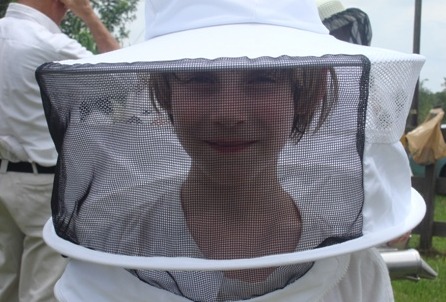Make a beekeeping suit
Make a simple, safe beekeeping suit using white clothing, mesh veil, elastic, and gloves; learn about protection and bee safety with adult help.



Step-by-step guide to make a beekeeping suit
young BEEKEEPING 101 kids training for real-world of beekeeping handling frames
Step 1
Put on the white long-sleeve shirt and pants to check that they fit comfortably and you can move your arms and legs easily.
Step 2
Put the white hat on and use the tape measure to measure the circumference where the mesh will sit and write the number down.
Step 3
Cut a piece of elastic to the measured length minus 2 centimeters so it will fit snugly around the hat.
Step 4
Lay the mesh flat and cut a rectangle about 25 to 35 centimeters tall and wide enough to go around the head when joined.
Step 5
With an adult's help, attach the elastic along one long edge of the mesh by sewing or using fabric glue so the mesh forms a loop that can slip over the hat brim.
Step 6
Pull the elastic-mesh loop over the hat brim so the mesh hangs down around your face and covers your neck area.
Step 7
Use safety pins or ask an adult to sew the bottom edge of the mesh to the inside of the shirt collar so the mesh sits snugly against your neck and chest without gaps.
Step 8
Put on the gloves and tuck each glove into the sleeve cuffs so the glove material meets the sleeve.
Step 9
Wrap a small piece of elastic around each wrist cuff to seal the gap between the glove and sleeve and secure with a stitch or a pin.
Step 10
Move your arms bend and turn your head to check visibility comfort and that nothing pulls or gaps while you move.
Step 11
Ask an adult to inspect every seam pin and elastic and to make any adjustments so the suit is safe and secure.
Step 12
Take a photo or write about your beekeeping suit and share your finished creation on DIY.org
Final steps
You're almost there! Complete all the steps, bring your creation to life, post it, and conquer the challenge!


Help!?
If I can't find the specific mesh, elastic, or fabric glue named in the instructions, what can I use instead?
Use fine mosquito netting or bridal tulle in place of the beekeeping mesh and cut it to the same 25–35 cm rectangle in step 4, replace elastic with a braided cord or an old hatband cut to the measured length minus 2 cm from step 3, and swap fabric glue for clear craft glue or use small hand stitches when attaching in step 5.
What should I do if the mesh loop keeps sliding off the hat or gaps appear at the collar when the child moves?
If the elastic-mesh loop slides off after step 5, shorten the elastic by 1–2 cm and add several small stitches or more glue along the seam, and if gaps appear at the collar after step 6 or while testing movement in step 11, re-pin the mesh closer together and have an adult sew the bottom edge into the shirt collar to seal it.
How can I adapt the activity for different ages or skill levels?
For younger children have an adult do the measuring in step 2, pre-cut the mesh in step 4 and use safety pins instead of sewing in steps 5 and 6, while older kids can practise measuring, cutting, and sewing (steps 2–6) and test mobility themselves in step 11.
How can we improve or personalize the beekeeping suit after finishing it?
Personalize and enhance the suit by sewing a name patch or reflective tape onto the shirt, adding a small inside pocket before the adult inspection in step 12, double-layering the mesh for durability when cutting in step 4, or adding a zipper or snaps at the collar to make step 6 easier to inspect.
Watch videos on how to make a beekeeping suit
Bee Suits & Jackets | Beekeeping Academy | Ep. 15
Facts about beekeeping for kids
⚠️ Worker honey bees have barbed stingers and usually die after one sting, so protective gear is important.
🐝 A full honey bee colony can contain anywhere from about 20,000 to 80,000 bees — lots of helpers!
🧥 Beekeepers prefer white or light-colored suits because bees react more to dark colors and patterns, so white helps keep them calm.
🔬 Bees can see ultraviolet light, which helps them find flower patterns humans can’t see.
🧤 Simple gear like elastic, a fine mesh veil, and gloves can greatly reduce stings while you safely help care for bees with adult supervision.
How do you make a simple, safe kids' beekeeping suit?
What materials are needed to make a child-friendly beekeeping suit?
What ages is this beekeeping suit activity suitable for?
What are the benefits and safety tips for kids making a beekeeping suit?


One subscription, many ways to play and learn.
Only $6.99 after trial. No credit card required


